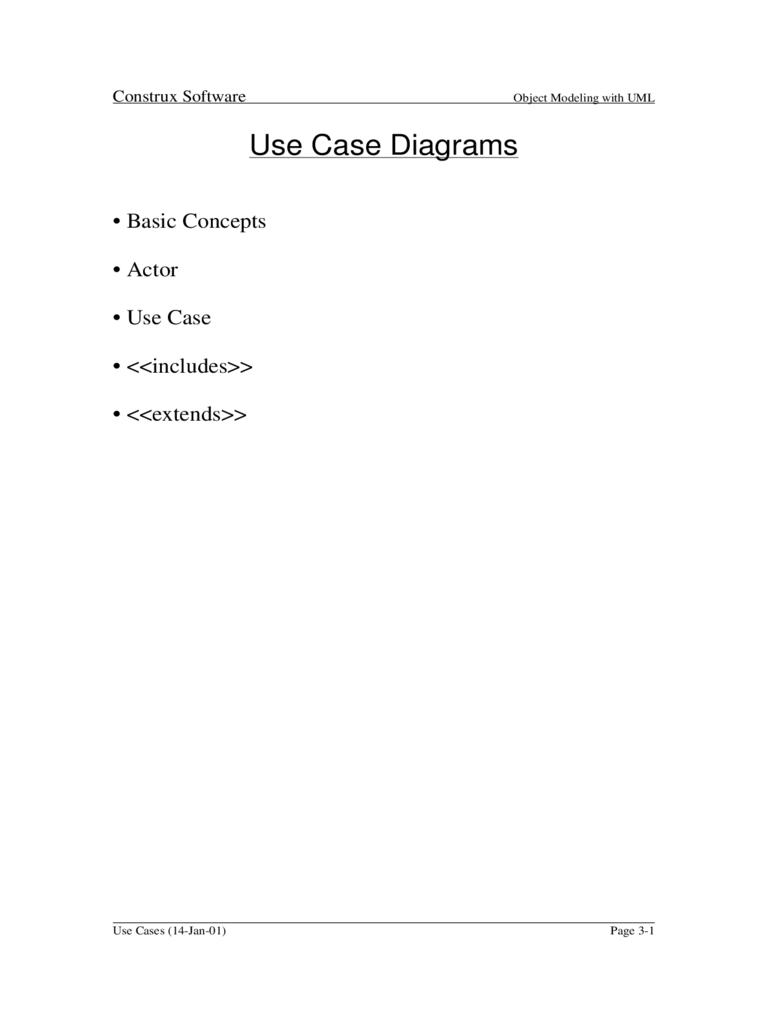Fillable Printable Use Case Diagrams
Fillable Printable Use Case Diagrams

Use Case Diagrams

Construx Software
Object Modeling with UML
Use Cases (14-Jan-01) Page 3-1
Use Case Diagrams
• Basic Concepts
• Acto r
• Use Ca se
• <<includes>>
• <<extends>>

Construx Software
Object Modeling with UML
Use Cases (14-Jan-01) Page 3-2
Basic Concepts
• Use cases are not inherently object-oriented
- An external (user) view of the system
- Intended for modelling the dialog between the users
and the system
• The main concepts in use cases are
- Actor
- Use Case
- <<includes>>
- <<extends>>

Construx Software
Object Modeling with UML
Use Cases (14-Jan-01) Page 3-3
Actor
• An Actor is a role of an object or objects outside of a
sy stem that interacts directly with it as part of a coherent
work unit (a use case)
- One phy sical object (or class) may play several
different roles and be modeled by several actors
• Notation
Reservation Agent
• Example actors for an Airline Reservation system
- Airline administrators (fare/schedule setting)
- Travel Agent
- Airline Reservations Agent
- Check-in Agents at Airport
- Gate Agent at Airport
- …

Construx Software
Object Modeling with UML
Use Cases (14-Jan-01) Page 3-4
Use Case
• A Use Case captures some actor-visible function
- Achieves some discrete (business-level) goal for that
actor
- May be read, write, or read-modify-write in nature
• Notation
Customer
Place Order
Check Status
Cancel Order
Salesperson
• Use cases within an Airline Reservation system might
include
- Checking in for a flight
- Assigning a seat
- Checking baggage
- …

Construx Software
Object Modeling with UML
Use Cases (14-Jan-01) Page 3-5
<<includes>>
• One common fragment of a user-perceivable action has
been pulled out into a separate use case
- Like a “use case subroutine”
• Example
Travel Agent
Make Reservation
Peruse
Available Flights
Arrange Tour
<<includes>>
<<includes>>
- Make Reservation and Arrange Tour both depend on
Peruse Available Flights
* Note that the arrows go from the dependent
use cases
• Typically used when the same unit of functionality is part
of more than one use case
- The base use cases are, in a sense, incomplete without
the included use case

Construx Software
Object Modeling with UML
Use Cases (14-Jan-01) Page 3-6
<<extends>>
• A significant alternative course of action exists within the
use case
- Like “use case inheritance”
• Example
Ticket Counter
Agent
Check In Passenger
Check Baggage
Assign Seat
<<extends>>
<<extends>>
- Assign Seat and Check Baggage both depend on
Check In Passenger
* Note that the arrows go from the dependent
use cases
• Typically used when there are important, optional
variations on the basic theme of the base use case
- The base use case is complete in and of itself

Construx Software
Object Modeling with UML
Use Cases (14-Jan-01) Page 3-7
Key Points
• Use cases are not inherently object-oriented
- An external (user) view of the system
- Intended for modelling the dialog between the users
and the system
• An Actor is a role of an object or objects outside of a
sy stem that interacts directly with it as part of a coherent
work unit (a use case)
• A Use Case captures some actor-visible function that
achieves some discrete (business-level) goal for that actor
• <<includes>> and <<extends>> allow common fragments
of use cases to be pulled out into a separate use cases
- <<includes>> is like a “use case subroutine”
- <<extends>> is an alternative course of action



